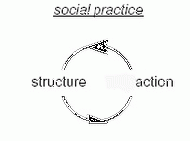Dualism
From Geography
The definition of dualism denotes there is a state of two parts; devision into two. It comes from the latin 'duo' meaning 'two'. It is thus about two factors which are assumed to be distinct and mutually exclusive and to have incompatible characteristics. For instance there is moral dualism which denotes the dualism between good and bad. In religion this can be seen as God (good) versus Satan (bad). In Chinese philosophy there is Yin and Yang. Dualism can be seen in several sciences, philosophies and religions. According to Aitken & Valentine (2009) is our culture defined with binaries like male/female, mind/body, east/west and so on.
Dualism by Anthony Giddens
Giddens Structuration Theory can be seen as an answer to the classis actor/structure dualism. Behavior and structure are intertwined; people go through a socialization process and than depend on the existing social structures, but at the same time social structures are being altered by their activities. Social structures not only restrict the behavior of people but also creates possibilities for their behavior, this is a duality.
Structuration theory is based on the premise that the classic actor/structure dualism has to be reconceptualized as a duality - the duality of structure. These can only exist as social conduct is reproduced chronically across time and space (Giddens, 1984).
References
Giddens, A. (1984). The Constitution of Society: Outline of the Theory of Structuration, Cambridge: Polity Press.
University of Twente. List of theories. [Found at http://www.utwente.nl/cw/theorieenoverzicht on October 24th 2012]
Aitken, S. & Valentine, G. (2009). Approaches to human geography. SAGE publications Ltd
Contributions
Page created by Doris Roelvink, October 24th 2012
Picture added by Doris Roelvink, October 25th 2012
Page edited by Michiel van Rijn, 25 October 2012
